Depending on what you use to view/photograph objects in close-up or macro, a set-up can be tailored as appropriate.
The only essential items are:
Image editing software can make captured digital images more dramatic. Distracting backgrounds can be painted out and changing the tonal balance can give the colours more 'punch'.An even white light source. I use a 60W photo-enlarger bulb but a desk lamp or external microscope lamp may be fine. Colour correction of the light for the camera isn't vital for creating aesthetic rather than scientific images.
Two fairly large polarising filters e.g. 4 cm square. One filter is mounted in front of the light and behind the object. The other is placed in front of the object and before the camera. This filter can be rotated to create the most desired effect. I use two polarising filters for an SLR camera 4 cm in diameter. But small squares of polarising filters can be obtained quite cheaply. At a pinch the two sides of a pair of plastic clip-on Polaroid sunglasses for prescription spectacles can be bought for a few dollars.
You can just view the objects or record the image with a camera with close-up or macro facilities. In my case I use an old colour security video camera with an SLR lens and extension tubes attached and send the video still to a PC capture card. But a digital stills (or film based) camera with good macro facilities should be fine.
Some suggestions on what to view
The plastic gauze from a first aid dressing
| Most first aid dressings like Elastoplast® have a plastic gauze over the internal pad to hold it off the wound. If this gauze is cut away from an unused(!) dressing (see right) and mounted on a glass slide for support they are often 'crossed polar' active. |
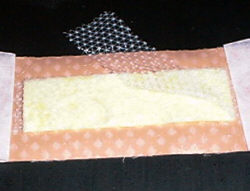 |
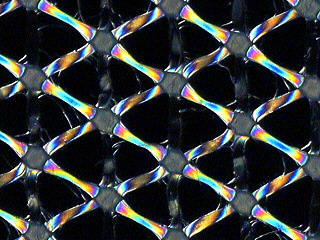 |
The gauze can be viewed under a compound microscope with a low power objective but a macro set-up (or stereo 'scope) may give a wider field of view of the gauze to create a more dramatic effect. |
Plastic boxes
Many clear plastic objects around the home may give colour effects. Not all plastics will work - just try a few and see! The stresses in the plastic around lettering, embossing etc. can create colourful effects.
| The image right shows the makers mark on a music tape cassette box. |
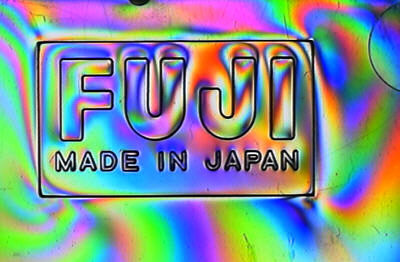 |
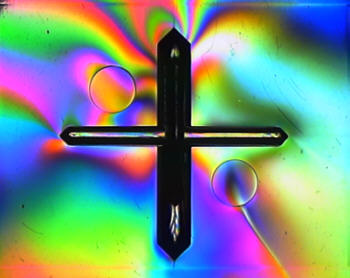 |
The same music cassette box showing one of the two cross-shaped pegs which hold the spindle of the cassette tape. |
| Try plastic boxes with ornate sculpturing. In this example the plastic box for holding the lens filter of an SLR camera responds well to the 'crossed polar' treatment. |
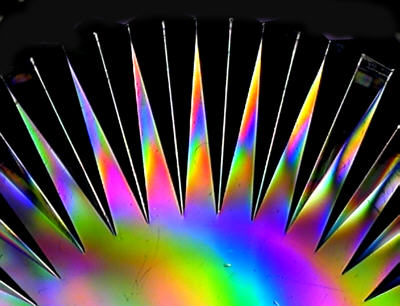 |
 |
Objects don't get more mundane than the familiar microscope coverslip box! But even this can be of interest between crossed polars. |
Glass objects
I didn't have many glass objects to hand, but glass ornaments, ashtrays etc. may work well. Glassblowers often use a large pair of Polaroid filters to inspect that the scientific glass apparatus they make has been correctly annealed to remove stresses.
| A very simple example right shows part of the base of a glass Petri dish which highlights some of the stresses. |
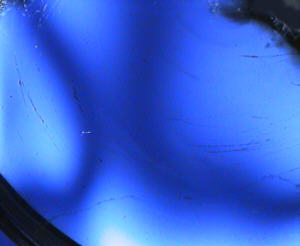 |
Plastic wrappers and sheets.
Try various plastic wrappers and sheets, not all will work but some should. I used a wrapper from a pack of sticky paper labels. Try cutting out various shapes from an 'active' wrapper and taping onto a rigid support like a music cassette box which is also crossed polar active. This can give some neat effects like 'mountain ranges' and 'skyscapes' or other abstract colours and shapes.
With some of the examples above it's also worth placing one or more of these 'active' sheets behind the subject, as it can not only change the colour effects of the object but also adds a dramatic background.
| The example right was a rough and ready trial of three overlapping pieces of cellophane(?) taped onto a music cassette box. But with care stunning effects can be created. (I thought the plastic sticky tape may give a contrasting band of colours but in this case was not effective, so the tape could be positioned out of the field of view). |
 |
Comments to the author Dave
Walker welcomed.
Further reading
This article explores a fun aspect of using polarising light, no theory required!
A good introduction to how polarising light works and its more scientific use in microscopy and materials science can be found in most introductory guides to microscopy. Although out of print, I found ref. 1 below particularly good.
Many enthusiasts also use polarising light with subjects like slides of crystals to create artistic effects under the microscope. For example Gwyneth Thurgood has written a fascinating series of articles in the Quekett Microscopical Club's publications (e.g. ref. 2 and 3). An article of hers with images is also on-line on the Quekett Microscopical Club web site.
1) 'Under the Microscope' by A Curry, R F Grayson & G R Hosey. Blandford Press, Poole, UK 1982. Now out of print but may be available in libraries or second-hand. An excellent introduction to the practical and theoretical aspects of microscopy (including polarised light) at a level suitable for the beginner. Includes a chapter on rocks, crystals and minerals.
2) 'The Hidden Landscapes of Crystals' by G Thurgood. Microscopy Bulletin (Newsletter of the Quekett Microscopical Club), 1992, 20, p12-14.
3) ''Landscapes' in microscopy
as an art form' by G Thurgood, Quekett Journal of Microscopy, 1995,
37 (6), p455-466.